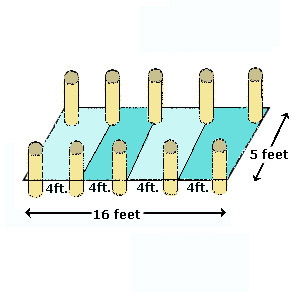Problem-solving is a critical 21st Century and social-emotional skill
The "draw a picture" strategy is a problem-solving technique in which students make a visual representation of the problem. This resource will help you help your students learn how to employ a fundamental problem-solving strategy that is easily grasped by learners of all abilities.Looking for more resources on 21st Century skills and social-emotional learning? Find them in our FutureFit resources center.
Solve the Problem
Students understand that there are posts every 4 feet. In the second sample problem, students are asked to organize data spatially to determine the number of posts Marah will need. They can draw a picture or a diagram to find the answer.

I drew a rectangle where each long side is 16 feet, and there is 1 post every 4 feet. I drew a circle for each post. I remembered to draw a post at each end. There are 10 posts total.
Check Your Answer
Ask students to read the problem again to be sure they answered the question.
I found that there are 10 posts.
Students should check their math to be sure it is correct.
16 divided by 4 is 4. There are 4 sections of 4 feet on each long side.
There is a post on each end, so 4 + 1 = 5. There are 2 sides to the tent, and 5 x 2 = 10.Discuss with students whether draw a picture was the best strategy for this problem. Was there a better way to solve it?
Drawing a picture was a good strategy to use for this problem because students might forget to count the posts on each corner unless they see them.
Explain How You Found the Answer
Students should explain their answer and the process they went through to solve the problem. It is important for students to talk or write about their thinking. There may be more than one way to represent a problem visually, and asking students to explain their picture helps to understand their thinking process and identify errors.
My answer is 10 fence posts. First, I tried to solve this by multiplying. I took 16 and divided by 4 to find the number of posts on each side. I got 4 posts on each side. Then I doubled it to get 8 posts total. I checked the problem and realized that there are posts on each corner, so I drew a picture so that I could see it and be sure the answer was correct.
I drew a rectangle to show the tent. Each long side is 16 feet, and there is 1 post every 4 feet, so I divided 16 by 4 to find out that there are 4 sections of 4 feet each. I drew a circle for each post, and wrote the number in the space between each post. I remembered to draw a post at each end. I counted the posts and found out that there are 10 posts total.
Guided Practice
Have students try to solve the following problem using the draw a picture strategy.
Tai wants to frame a 3 x 5 picture surrounded by 2 inches of mat. How large will her frame need to be?
Have students work in pairs, groups, or individually to solve this problem. They should be able to tell or write about how they found the answer as well as be able to justify their reasoning.
How Can You Stretch Students' Thinking?
Some students are visual learners and work well when problems are illustrated or easy to see. Encourage students to draw pictures or diagrams for problems they find difficult. Encourage students to label all parts of their drawings. Students should understand that their drawings do not need to be perfect. Rather, their drawings need only represent the problem accurately and clearly show their thought processes.














